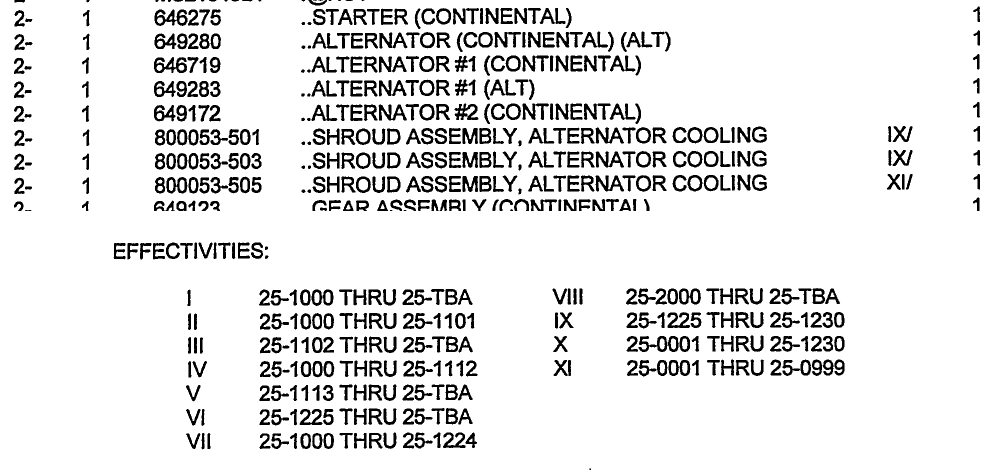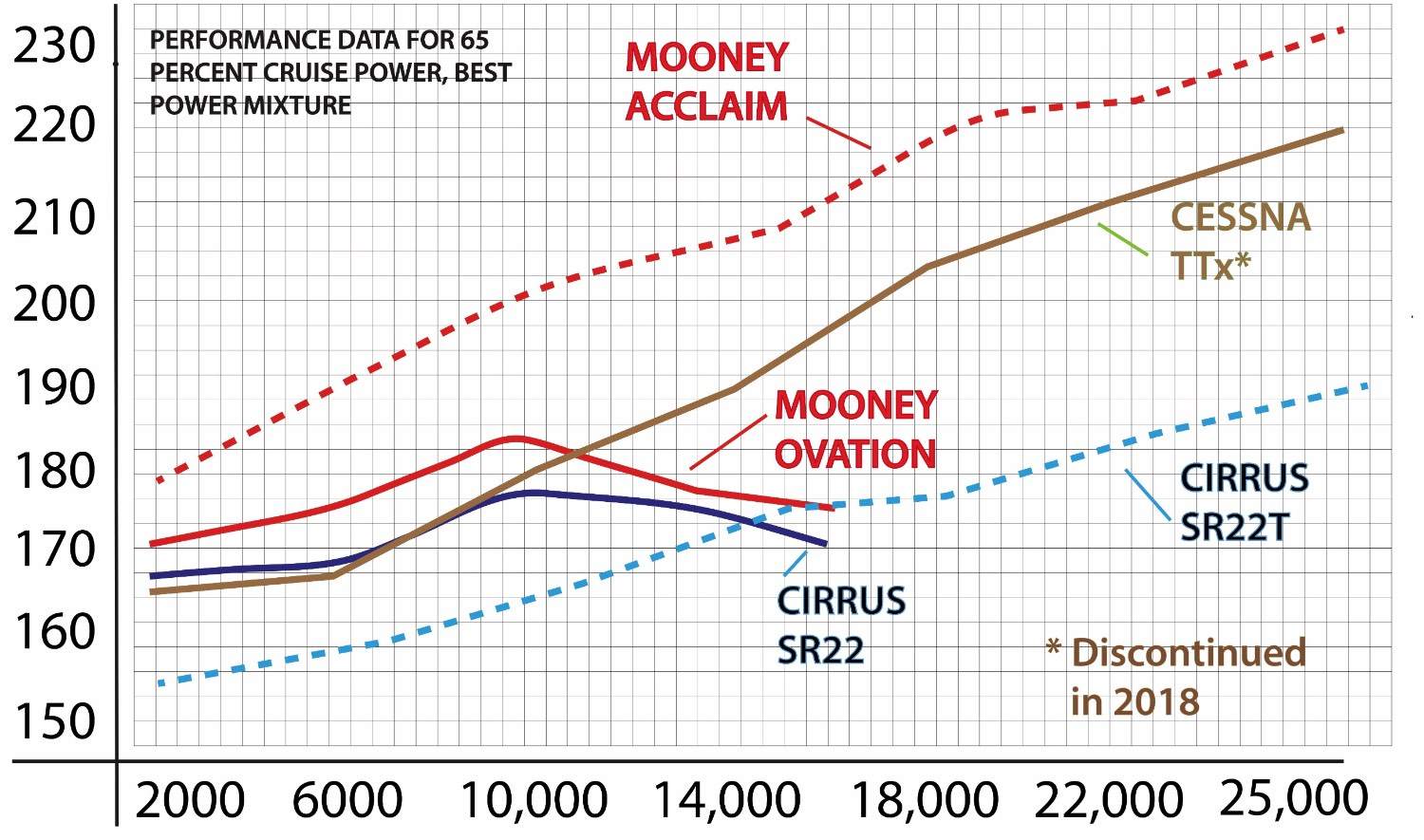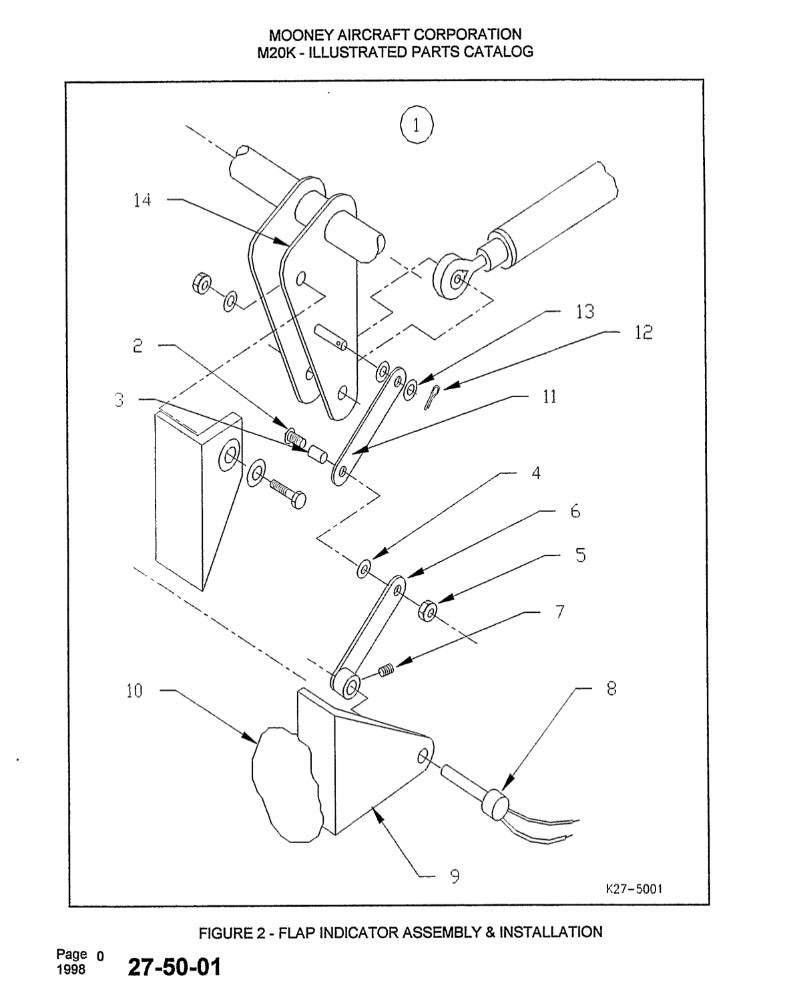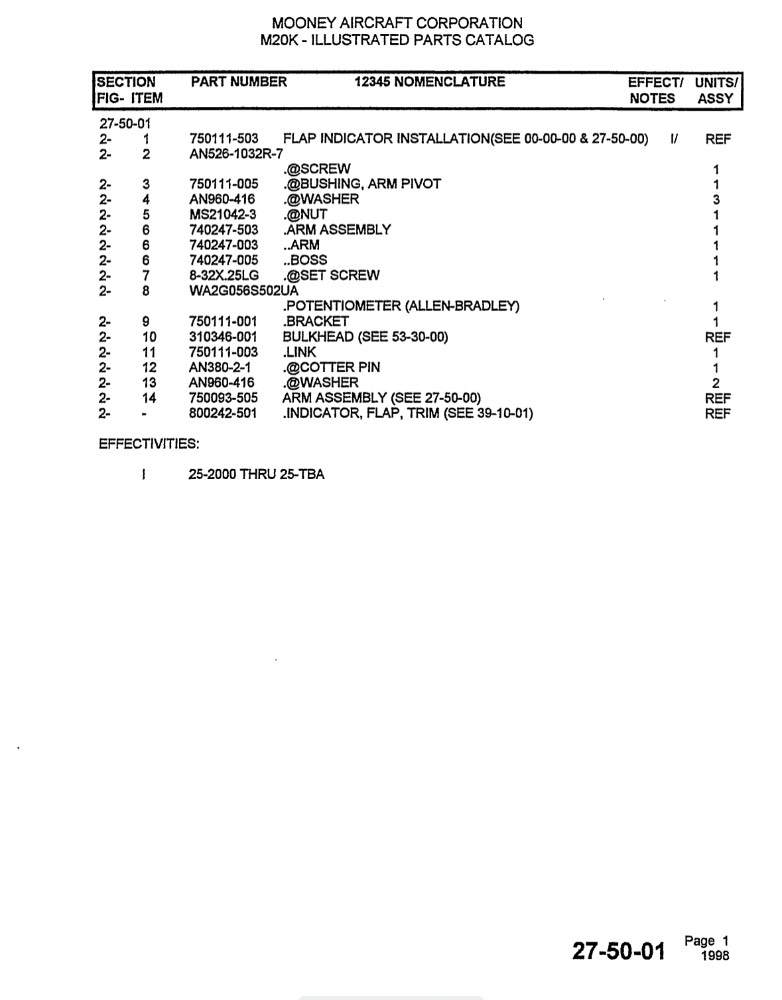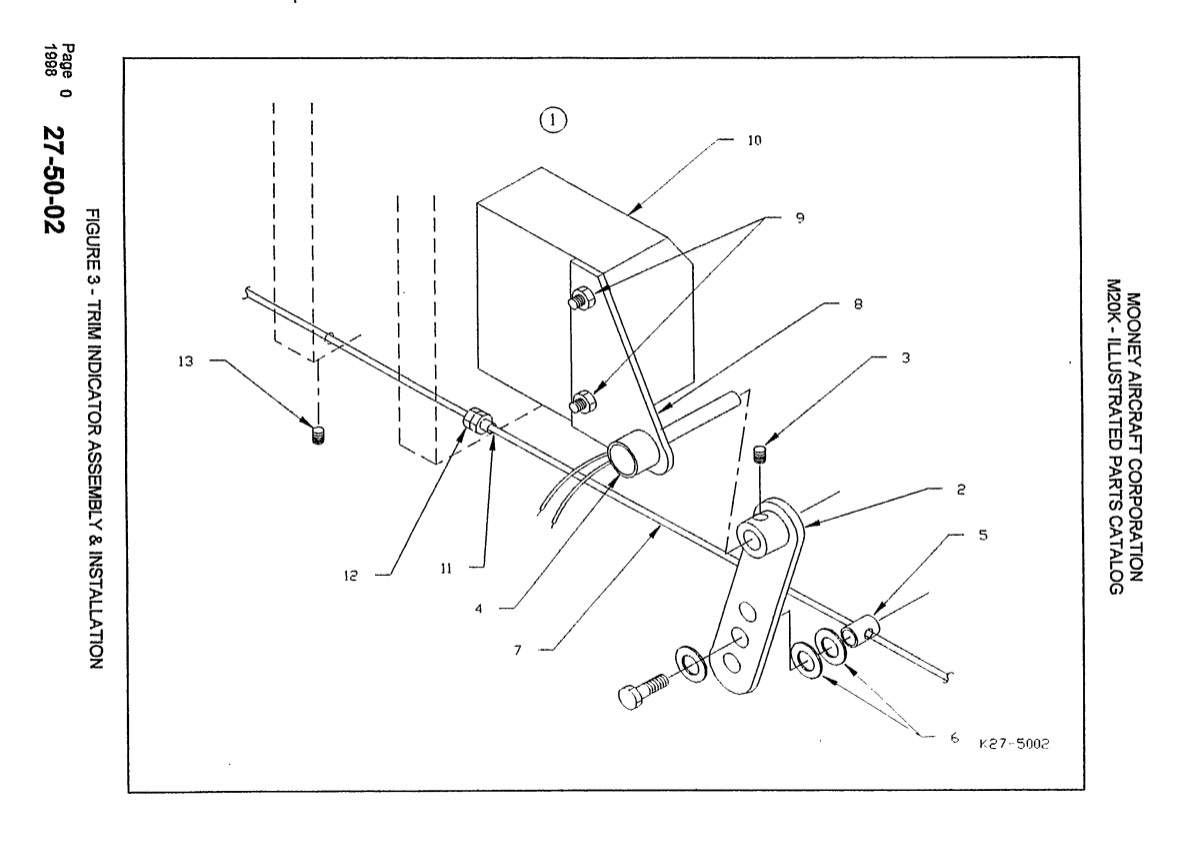-
Posts
1,297 -
Joined
-
Last visited
-
Days Won
10
Content Type
Profiles
Forums
Blogs
Gallery
Downloads
Media Demo
Events
Everything posted by Marc_B
-
Alternator cooling shroud assembly pn: 800053-501, -503, or -505. I'm not sure what the differences are between them (I suspect they fit the profile for different alternators). I added the effectivities to the screen shot above. This was from the M20K IPC. And it's interesting that you have #653344 alternator mounted? The TCM parts catalog shows that as the gear drive alternator, and #649283 as the belt drive alternator. I looked back and couldn't find a picture on my computer showing of my belt drive part number. I'll have to take a look next time the cowl is off.
-
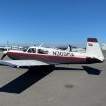
Has the Mooney Caravan abandoned Mooneyspace?
Marc_B replied to Rick Junkin's topic in Mooney Caravan
Weather/taxiing on grass during Osh (for any participant) could be a concern as there is typically weather that rolls through at some point every year. 2022/2023 had some crazy rain storms that passed through Saturday night/Sunday after the Mooney Caravan arrived. We found that quality outdoor tents were a nonissue, but the el cheapo Walmart special tents got turned into to flattened bath tubs! That year the Caravan vehicles and board went to the local outdoor store and picked up all the tents they had for the unfortunate fishies. This year rain rolled through and I think everyone was unscathed. It never lasts long, and the HUGE Caravan circus tent is a great place to congregate, drink a cold one, and chat with your fellow Mooney pilots as the bugs get washed off your wings. The taxi marshallers do a good job of placing cones on low spots and the grounds dry out pretty quickly as the remaining days are typically SUNNY. I still taxi decently slow/carefully, yoke pulled back to my chest, and they do a great job of rolling the grass smooth for the show. The three times I've been at Osh, I had no problem taxiing where I was being directed. We did have a pilot this year peel off after landing and go to general aviation parking area; he wasn't staying/camping at Osh but wanted to come with the Caravan. So it is possible to park somewhere else...although I think it's WAY more fun to camp beside your Mooney! Securing Aircraft: This is probably one of the benefits of the Caravan. You're surrounded by mass arrivals and I think that most mass arrivals are ahead of the curve in terms of Osh camping! These are the aircraft that usually have LED solar lights, cutting boards under the wheels, the Claw type tie downs, canopy covers, camp seating, etc. Given that most of the Caravan are seasoned vets, you can be sure none of the aircraft around you are going anywhere for most weather that would be coming through. I've found that the Claw is a great tiedown to use, works well, and easy to place and remove. Leaving Osh: Most pilots bring wooden or plastic cutting boards for the wheels; it distributes the weight over a larger footprint to keep from sinking into the grass as much. I picked up 3 cutting boards from Sam's that I reuse every year. Still, it takes more than just you to pull your aircraft out, but fortunately you have a whole group of Mooney friends to help make it easy! Food: The caravan always plans a group dinner every year under the tent. There are also several group meals that get planned in Madison as well as at Osh. Breakfasts are included Sunday - Wednesday under the tent each morning (part of the small Caravan registration fee). Lunches you are on your own. This year there were several that brought coleman stoves and we cooked out steaks or hotdogs. Food is definitely something that seems to get refined every year! At the clinic I attended there was one pilot who had some issues with feeling comfortable with engine management and trusting that his engine settings were fine (they were). But after a couple sorties with a seasoned safety pilot in the right seat he wasn't quite ready...and he wasn't signed off. But despite that there was never a problem with safety of flight, and that pilot has the opportunity to continue to learn and attend a future clinic to continue training. Hopefully as he improves, formation flight will gel and he'll join us. But if not, we still had a great time meeting another Mooney pilot and I'm sure he learned a lot in the process. Sometimes Formation flight may not be for you, but you don't know that till you try. If at any time a pilot feels unsafe, they can always call knock it off...for any reason. This is ingrained into the training both for your safety and the safety of others. BTW, we also have had a Beech pilot that joined that didn't get signed off. So it's not a gimme to get approved to fly in the Caravan. And if not for formation flying...how else are you supposed to get cool pictures!! -
Nice! I think this is one job that new definitely doesn't = better. Probably the glue/epoxy will be stronger than the thin material this is made out of. The heat cycles under the cowl have to be taxing on thin plastic materials! Edit: And if you do ever replace it, post back up where you found a part available and cost!!
-

This guy is an embarrassment to Mooney pilots.
Marc_B replied to Brandt's topic in Mooney Safety & Accident Discussion
https://www.planeandpilotmag.com/article/is-glass-safer/ https://www.ntsb.gov/safety/safety-studies/Documents/SS1001.pdf "Advanced avionics and electronic displays can increase the safety potential of general aviation aircraft operations by providing pilots with more operational and safety-related information and functionality, but more effort is needed to ensure that pilots are prepared to realize that potential." NTSB But the discussion is more nuanced than the broad brush strokes being painted of advanced equipment is unsafe. Consider that the majority of GA pilots today learned to fly with conventional equipment, the FAA knowledge exams are steeped in round dials and have limited testing pertaining to glass panels, the lion share of training aircraft are round dials, and the vast majority of AATD/BATDs are based on round dials. Familarity and uniformity go a long way. Once we actually start comparing apples to apples and review how pilots are trained and tested, then we can actually have better data to compare the variations of equipment. The silver bullet to safety is pilot training and proficiency with whatever equipment you're using. -

This guy is an embarrassment to Mooney pilots.
Marc_B replied to Brandt's topic in Mooney Safety & Accident Discussion
What I think would decrease accident rates: High fidelity simulation, more routine and structured training, and better testing/assessment of skill and deficiencies. For 121 ops this is a given. For GA pilots it's not mandated, easy, or inexpensive....and it's almost 100% self (pilot) driven. -

This guy is an embarrassment to Mooney pilots.
Marc_B replied to Brandt's topic in Mooney Safety & Accident Discussion
I hear what you're saying Vance. But poor pilot skills, lack of education, hazardous attitudes, and poor ADM has nothing to do with equipment and everything to do with the person. And this is why the accident rate remains unchanged despite technological advances. Over 2/3 of accidents are "attributed to" pilot-related. (link is attached). edit: see below posts doesn't include "unknown" that were likely pilot-related as well. But maybe what you're trying to point out is that capability and safety are not synonymous. Completely agree. -
Common occurrence I think and I couldn’t find a replacement. But JB Plastic Weld works like a charm to glue it back securely and just check it with each oil change. If you take your time and glue it well it’s good to go! It’s just a cooling shroud so doesn’t need to be perfect and pretty to do its job. EDIT: 653344 is the gear drive alternator part number, but you're right that belt driven alt considered #1 alternator. IIIRC, I couldn't find the cooling shroud PN on the TCM parts catalog, and from the Mooney IPC it appears to be a Mooney part number? I can't seem to find an email or details but I keep thinking that perhaps Mooney or LASAR could get them for around $600-700...or perhaps I just couldn't find one at all so I just glued it and still solid 2 annuals later.
-

This guy is an embarrassment to Mooney pilots.
Marc_B replied to Brandt's topic in Mooney Safety & Accident Discussion
Modern glass panel allows increased situational awareness for navigation as well as on screen traffic and terrain. Most have ADS-b weather and some have XM weather. Most have easy access to the comprehensive list of diversion fields with weather, frequencies, runway lengths and currently favored runways, as well as the full database of what IFR procedures exist. Loading a different approach is very easy whether that's due to downgraded approach, NOTAM out of service, equipment issue, or a simple change in winds resulting in a change in airport flow. Glass panels have a clear graphic display of TFRs, airspace boundaries, and changeovers for ATC/Center freqs. Many glass panels allow you to set up altitude constraints at distances to a fix so that if VFR you can pre-plan altitude descents to make sure you don't accidentally bust airspace boundaries. They can use inflight data to help calculate fuel burn and reserves, calculate ETAs, instantly show all your position report data. Full screen panels can show your entire route to quickly see if you had a fix misspelled and it jumps off course unexpectedly later in your route. Regarding weather, I wouldn't use XM or ADS-B weather to navigate storm cells, but on a 3-5 hr flight, how accurate was that weather brief you got a hour before departure? If you were checking wx enroute and saw a change, perhaps you might have just stopped for fuel and a pitstop short of the destination. Or maybe your planned approach/runway from your brief changed en route and you can anticipate what your plan is on arrival...and perhaps do a better job of briefing the missed and already having plan B solidified in your mind. Regarding a modern autopilot, single pilot IFR can be a large workload but with a properly functioning AP it allows the pilot to monitor the big picture and not just focus on vertical and horizontal flight. Incidental VFR into IMC or an episode of spatial disorientation, just press the blue LVL button and let the AP help you regain control. AP allows you to fly more precisely and sometimes more smoothly than you'd typically hand fly (of course some times, i.e. turbulence, I'd rather hand fly). With a GPS and coupled AP it opens the complete list of fixes within the FAA database and even allows you to create user fixes on radials, DME/radial, and radial/radial pretty quickly and easily. You can easily set up a course around MOAs, TFRs, or airspaces you'd like to avoid. The addition of smart glide gives you assistance at a critical phase of an emergency so that hopefully you minimize altitude loss and distance to your closest field, and maximize the time and glide distance you have to fly the aircraft and work the problem. It also allows you to easily squawk emergency, tune 121.5, and gives you info about the closest airport to you. Regarding failure rates...Rate of vacuum failure much higher than glass panel failure. A failing vacuum system much harder to quickly and clearly identify rather than a red X. Glass panels have more integrated alerting for a variety of things from stabilized approach alerts, terrain alerts, sink rate alerts, traffic alerts, etc. Accidents happen and lots of them happen due to the pilot. No equipment, no matter how safe, is going to protect the pilot from themself. But to deny the added ability and safety margin just because someone might not take the time to learn the equipment doesn't make sense to me. But you are right to say that equipment alone doesn't = safety by itself. Shortly after I purchased 8MA, I was flying VFR (didn't have IR yet) into KDAL (Dallas Love), had filed a flight plan, spoken with FBO at DAL, and had flight following. Thirty nm north of destination, ATC tells me "Dallas Love isn't accepting VFR traffic, say intentions." I quickly pulled up my map screen, had previously considered KADS (Addison), so told ATC "I'll divert to Addison if that works." Within minutes I had new destination plugged in, frequencies set, had the wx & NOTAMs, and already knew what runway I'd be using. For a relatively new Mooney pilot flying into a busy airspace it was really seamless and allowed me to focus on flying the aircraft and not digging though charts or having to memorize all the areas in my preflight. It was not just safer for me, but all the traffic in the area as well as being smooth and efficient with ATC and avoiding having to circle in a busy airspace while I came up with a plan B if I didn't already have one or needed to go to plan C. -

Major versus minor alteration; voltage regulator
Marc_B replied to Jetrn's topic in Modern Mooney Discussion
I suspect you mean Kenneth Snowden. I hope he's okay, but suspect that he may be close to retirement anyways as he's been with IAI for a LONG time! I hope IAI has another service tech in training, as when I was dealing with the same issue for 28V dual regulator there was nothing PMA'd for this and I was told by Don Maxwell that they could service VR's but if it was an IAI regulator it would have to go back to them. -

This guy is an embarrassment to Mooney pilots.
Marc_B replied to Brandt's topic in Mooney Safety & Accident Discussion
My personal opinion is that is a characteristic of the pilot, and not inherent or a characteristic of the machine. I'm sure there are pilots that don't understand vacuum system failures and won't be able to recognize their AI failed and how to crosscheck. But in my mind, I expect from myself more than a rudimentary knowledge of the equipment. The comment above could be said about any aspect of the aircraft...retractable gear vs fixed, constant speed prop, etc. Like I mentioned, the minimum price of entry to the air is actually quite low and the standard training aircraft are designed to be the most easy to fly. But you're right...basic experience and education gives you basic skill at best. You have to continue to work at it to improve. -

Instrument Approach Gear and Flap Sequence - A survey
Marc_B replied to midlifeflyer's topic in General Mooney Talk
One other tidbit picked up during instrument training: When I drop gear the Mooney wants to balloon a little; I can easily control that tendency, but it's easier to do this under the GP/GS then "at" the FAF as it allows me to be better stabilized by the FAF and verify "Glidepath captured, altitude checks, setting missed approach altitude." Being configured a little before the FAF makes those mental checks for proper baro/altitude, setting altitude bug, etc all the more easy to do. When I'm juggling too much right at the FAF it makes that not quite as smooth/finessed. Also good to hear of @donkaye & @PT20J's SJC flow. This fits similar to what I've found in my K, that gear drops speed about the same degree as speed brakes, both around 20-25 kts each; and all in around ~5miles. -

Instrument Approach Gear and Flap Sequence - A survey
Marc_B replied to midlifeflyer's topic in General Mooney Talk
For me, before the FAF has variability due to "keep best forward speed for traffic" or "slow to final speed for traffic" and everything in between depending on what ATC and traffic dictate. But I've found that pulling throttle back and leveling off takes ~5 miles and 2.5 min to equilibrate the speed with new configuration from a fast descent. So I have to drop throttle at least 5+ miles before the FAF to make sure I'm below 140kts for gear if I'm "best forward speed" for the first part of an approach especially if also descending. (I've also found that dropping gear drops my speed by about 20-25 kts if everything else stayed the same) If trying to slow down from the IAF, then I'll usually drop to 20" MP...this keeps the engine warm enough, but the aircraft slow enough to feel like I have lots of time for the approach. During instrument training I was taught to drop gear when the GP/GS is one dot above on the VDI. So for a standard approach to land, gear down one dot above, then throttle to 15" MP (90 kts) on the GP/GS, and flaps 10 deg checking to make sure I'm below 112 KIAS. On most instrument approaches I land with 10 deg of flaps only. Usually the runway is plenty long, and this avoids a big trim force/pitch up with go around. I usually don't start dialing back throttle until I'm roughly around ILS/LPV minimums with intent to land. -

This guy is an embarrassment to Mooney pilots.
Marc_B replied to Brandt's topic in Mooney Safety & Accident Discussion
Maybe the solution is to have the personal minimum that "I'm not going to fly into situations that I wouldn't feel comfortable hand flying." The only problem is that weather is dynamic and a lot of these situations weren't "intentional" choices. So the follow up is "I will try to leave myself an out if things change and I don't like the way it is developing." -

This guy is an embarrassment to Mooney pilots.
Marc_B replied to Brandt's topic in Mooney Safety & Accident Discussion
@kortopates I'd echo that to say that in the era of steam gauges there was MUCH more instrument uniformity from one aircraft to the next. Modern panels have so many unique quirks that currency is minimum price of entry, but not even remotely in the realm of proficiency. How modes change, how the approach sequences, where you find the "gotchas" with equipment surprises...I think this is the appeal of teaching "universalisms" like GPS Reeves teaches...he tries to teach "always do this" or "never do that" just to try to minimize the gotchas sometimes instead of teaching the myriad of nuances of how complex the modern glass panel can sometimes be. I got my instrument rating in my Mooney, have flown it for 3 years and over 500+ hrs, attended a PPP, attended an onsite Garmin course, and like to go out and figure out why it does stuff the way it does...and I'm still surprised sometimes...and this is with an all Garmin panel...once you start mixing and matching a lot of the time the quirks rise exponentially. The hard part is that you can't simulate every single issue you might run into. Sometimes it's obvious and easy...sometimes it's a head scratcher and it won't be figured out that flight. For me, this is where accidents, "There I was" podcasts, and AOPA ASI reviews help fill in the gaps of what goes wrong to help fill the neurons for what would I do? I would argue that more capable and integrated panels with a fully featured autopilot afford a WAY larger safety margin for the GA pilot. But they come at the cost of more sophistication from the panel requiring more sophistication from the pilot. But at the end of the day the meat sack in the left seat is still the PIC and not the electrons behind the panel. So the level of safety afforded is only as good as the pilot. But the reason we have these issues is that minimum price of entry to the sky is actually rather low. So safety is dictated by rational, smart, educated, and conservative decisions...and we all know how dumb our decisions can be and how stupid humans are sometime. -
This happened to me as well (M20K Encore); it’s easy to short them but I think the fuse was in the avionics compartment.
-

This guy is an embarrassment to Mooney pilots.
Marc_B replied to Brandt's topic in Mooney Safety & Accident Discussion
100% and not just students. I spent some time at Osh checking out some of the NATCA lectures and it is always interesting to see the resources available to ATC that you might not realize were available to you if they weren't volunteered to you or specifically requested. But I think its always difficult to fess up that you're in a bad situation especially if/when you feel that it may be your fault or due to your choices. It was interesting to hear ATCs view of minimum fuel vs fuel emergency... I hope if the time comes I have the discipline to be calm, embrace the emergency that exists, and ask for the right help. Duck your head and barrel on to disaster is all too easy sometimes. -
I've read that potentiometers have some dielectric grease of some type that gets washed way by contact cleaners and the general gist was that it improves the corrosion temporarily but that it speeds up the degradation of the pot. Of course if it's a matter of kicking the can down the road to eventually replace, it might be worth it? Seems like the internet is back and forth regarding should you clean potentiometers and how...but its seems like Deoxit is a common recommendation. (I'm not an electrical engineer, and have no way to validate what optimal care of your potentiometers may be).
-

This guy is an embarrassment to Mooney pilots.
Marc_B replied to Brandt's topic in Mooney Safety & Accident Discussion
I usually read to these threads with a grain of salt. Meaning we usually will never know what was going on in the cockpit or with the equipment that day. It’s easy to get lulled into the mindset that “it will never happen to me” or “I’d never put myself in that situation.” But we all know that situations happen and we don’t rise to the occasion, but fall to the level of training we have set for ourselves. So instead of pointing out flaws, I like to imagine this was me and I need to learn from it. What happens when wx changes and isn’t what was forecast? What happens when something isn’t working right? What happens when the autopilot fails with a difficult approach required. the sad part is that these stories are numerous but yet we all don’t seem to learn from them. When things go wrong humans can get so incredibly tunnel vision focused it’s truly amazing. Helmet fires don’t just happen to the ignorant, they happen to us with new experiences that our minds are trying to sort out. I think “that would never be me” should be added to the FAA Hazardous Attitude list. The cure is “this could happen to me.” -
https://www.aviationconsumer.com/industry-news/editorial/mooney-acclaim-ultra-tops-in-raw-speed/ reading this thread made me think of this article.
-
I don’t have a pic of the indicators but here are the IPC pages for trim and flap indications. It is displayed on the multifunction lens in the center console with LED boxes like @Rick Junkin has above, but 4 of them all together in one large lens that has flaps, trim, cowl flaps, elevator trim all together.
-
The materials aren't that expensive, but the labor is what gets you. My shop charged me 15 hours for replacement, which was right around your quote. It's one of those tedious projects that you can do yourself to save money, but shop might do it faster and cleaner. GeeBeeAeroproducts sells a baffle seal kit and might have one for you that's precut and sent with all the rivets.
-
@MikeOH Call the hotel. It’s all be reserved for MooneyMax so has no availability unless you call and let them know you’re there for the event.
-
I think these minimum mileage criteria are always sneakers…that’s what screwed Jessica Watson on her solo sail around the world at age 16. Still impressive, but has to chafe! https://en.m.wikipedia.org/wiki/Jessica_Watson
-
@Dmax Have you finalized the schedule? I was also curious about details of the Mooney tour if that’s been setup? Thanks!!
-
I got a Uscooter. https://uscooters.com/ It's got about 25 mi range and goes over 20mph. Foldable and doesn't take up much room. The model I have weighs about 27 lbs. Cost around $800 IIRC. Makes it easy to use around the airport and take in the aircraft. It free wheels well, which is one of my requirements in case I ran out of juice...I could tolerate it turning into a nonpowered scooter, but couldn't stand it turning into a 27# brick! Edit: it will work with 2 people but due to the short handlebar width it feels twitchy with 2. I've seriously considered an addition of skateboard and a tow rope for traveling with two! ha ha. So much fun but I'm not the young, rubber gumby skater dood that I was when I was 12!




